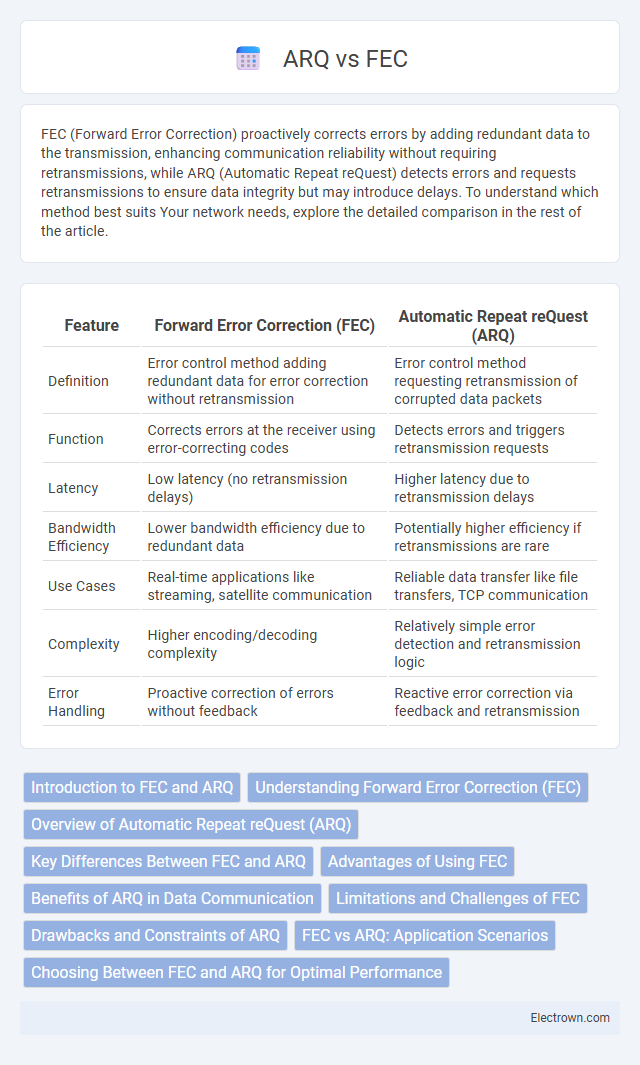FEC (Forward Error Correction) proactively corrects errors by adding redundant data to the transmission, enhancing communication reliability without requiring retransmissions, while ARQ (Automatic Repeat reQuest) detects errors and requests retransmissions to ensure data integrity but may introduce delays. To understand which method best suits Your network needs, explore the detailed comparison in the rest of the article.
Table of Comparison
| Feature | Forward Error Correction (FEC) | Automatic Repeat reQuest (ARQ) |
|---|---|---|
| Definition | Error control method adding redundant data for error correction without retransmission | Error control method requesting retransmission of corrupted data packets |
| Function | Corrects errors at the receiver using error-correcting codes | Detects errors and triggers retransmission requests |
| Latency | Low latency (no retransmission delays) | Higher latency due to retransmission delays |
| Bandwidth Efficiency | Lower bandwidth efficiency due to redundant data | Potentially higher efficiency if retransmissions are rare |
| Use Cases | Real-time applications like streaming, satellite communication | Reliable data transfer like file transfers, TCP communication |
| Complexity | Higher encoding/decoding complexity | Relatively simple error detection and retransmission logic |
| Error Handling | Proactive correction of errors without feedback | Reactive error correction via feedback and retransmission |
Introduction to FEC and ARQ
Forward Error Correction (FEC) and Automatic Repeat reQuest (ARQ) are two fundamental error control techniques used in digital communication to ensure data integrity. FEC enhances data reliability by adding redundant information to the transmitted message, allowing the receiver to detect and correct errors without needing retransmission. ARQ relies on acknowledgments and retransmissions, where the receiver requests the sender to resend corrupted or lost packets, ensuring accurate data delivery through feedback mechanisms.
Understanding Forward Error Correction (FEC)
Forward Error Correction (FEC) enables proactive error detection and correction by embedding redundant data within transmitted messages, enhancing communication reliability without the need for retransmissions. Unlike Automatic Repeat reQuest (ARQ), which relies on feedback and retransmission upon error detection, FEC reduces latency by allowing receivers to correct errors independently. Your network performance improves significantly in high-latency or unreliable environments through effective FEC implementation.
Overview of Automatic Repeat reQuest (ARQ)
Automatic Repeat reQuest (ARQ) is an error control method used in data transmission that relies on acknowledgments and retransmissions to ensure data integrity. It detects errors through mechanisms like cyclic redundancy checks (CRC) and requests retransmission of corrupted packets. ARQ protocols, including Stop-and-Wait, Go-Back-N, and Selective Repeat, balance reliability and latency depending on network conditions.
Key Differences Between FEC and ARQ
Forward Error Correction (FEC) transmits redundant data to enable error correction at the receiver without requiring retransmissions, while Automatic Repeat reQuest (ARQ) relies on error detection and retransmissions for correction. FEC offers lower latency and continuous data flow, making it ideal for real-time applications, whereas ARQ can be more bandwidth-efficient by retransmitting only erroneous packets. The primary difference lies in FEC's proactive error correction versus ARQ's reactive error handling through feedback mechanisms.
Advantages of Using FEC
Forward Error Correction (FEC) enhances data transmission reliability by proactively correcting errors without the need for retransmissions, leading to lower latency and increased throughput. FEC is especially advantageous in environments with high packet loss or long delays, such as satellite communications or streaming services, where retransmission delays are costly. Your network efficiency improves because FEC reduces the demand on bandwidth that would otherwise be used for repeated data requests in Automatic Repeat reQuest (ARQ) systems.
Benefits of ARQ in Data Communication
ARQ (Automatic Repeat reQuest) enhances data communication by ensuring reliable transmission through error detection and retransmission of corrupted packets, which helps maintain data integrity. It adapts dynamically to varying network conditions, minimizing data loss and improving overall communication quality. You benefit from ARQ's ability to provide error correction without adding significant overhead, making it ideal for networks with unpredictable error rates.
Limitations and Challenges of FEC
Forward Error Correction (FEC) faces limitations such as increased bandwidth consumption due to redundant data transmission, which can reduce overall throughput efficiency. It introduces encoding and decoding complexity, leading to higher computational overhead and potential latency, particularly in real-time applications. FEC's fixed error correction capability struggles with variable channel conditions, often requiring adaptive schemes to maintain optimal performance under diverse noise and interference scenarios.
Drawbacks and Constraints of ARQ
ARQ (Automatic Repeat reQuest) faces drawbacks such as increased latency and bandwidth consumption due to the need for retransmissions upon error detection. Its performance degrades significantly in high-error or high-latency networks, causing frequent delays and reduced throughput. Your network's efficiency may suffer when ARQ repeatedly retransmits corrupted packets, limiting its scalability for real-time or high-speed communication systems.
FEC vs ARQ: Application Scenarios
Forward Error Correction (FEC) is ideal for real-time applications such as live video streaming and voice over IP, where low latency and continuous data flow are critical, as it enables error correction without the need for retransmission. Automatic Repeat reQuest (ARQ) is better suited for non-real-time applications like file transfers and emails, where data integrity is prioritized over delay since errors are corrected through retransmissions. FEC reduces bandwidth overhead by encoding redundancy proactively, while ARQ improves reliability by requesting retransmission only when errors are detected.
Choosing Between FEC and ARQ for Optimal Performance
Choosing between Forward Error Correction (FEC) and Automatic Repeat reQuest (ARQ) hinges on network conditions and application requirements; FEC is ideal for real-time transmissions where low latency is critical, as it proactively corrects errors without retransmissions. ARQ suits environments with fluctuating error rates, relying on acknowledgment and retransmission mechanisms to ensure data integrity, which can increase latency but maximizes reliability. Your decision should balance latency tolerance, bandwidth availability, and error rate to optimize overall communication performance.
FEC vs ARQ Infographic

 electrown.com
electrown.com